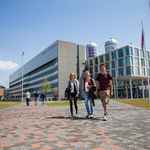IBED Seminar by Seppe Kuehn
- Date
- 10 April 2025
- Time
- 16:00 -17:00
- Location
- Science Park 904
- Room
- A1.28
Speaker
Dr. Seppe Kuehn
Abstract
Microbial communities exhibit extraordinary complexity, encompassing thousands of species, spatial organization, ecological interactions, and dynamic behaviors. Despite this complexity, these communities consistently drive robust ecosystem services, such as key metabolic transformations that sustain local ecosystems and regulate global biogeochemical cycles of carbon, nitrogen, and other elements. Microbiomes serve as the planet's metabolic engines.
|
Microbial communities exhibit extraordinary complexity, encompassing thousands of species, spatial organization, ecological interactions, and dynamic behaviors. Despite this complexity, these communities consistently drive robust ecosystem services, such as key metabolic transformations that sustain local ecosystems and regulate global biogeochemical cycles of carbon, nitrogen, and other elements. Microbiomes serve as the planet's metabolic engines. This raises a fundamental question: how do these emergent functions arise from interactions among community members? Specifically, how do genotypes, traits, and interactions shape community structure and determine functionality? Moreover, how do such communities achieve robust functionality and respond to environmental changes? In my lab, we address these questions by applying biophysical approaches, integrating quantitative measurements, minimal models, and statistical reasoning. I will share recent findings illustrating how a quantitative perspective can disentangle microbiome complexity and reveal the principles underlying their metabolic capabilities. First, I will discuss interactions between phytoplankton and their associated bacteria, a cornerstone of the global carbon cycle. Next, I will examine denitrification in soil microbiomes, highlighting how biophysical methods elucidate system-level responses to environmental change. |
